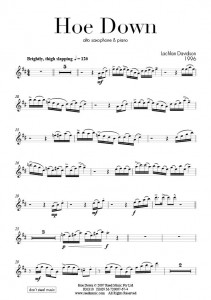Composed: 2003 Duration: 5 mins.
Instrumentation: Sax Soprano & Piano
Exam Grade: AMEB Saxophone Tenor Grade 7,
HSC Saxophone Tenor
ISMN: M-720067-74-2 Catalogue: RM316
Level: C Country: Australia
 Also available for Alto sax solo with Big-band A jazz band with a violin solo, a sax quartet featuring Soprano Sax, a big band featuring violin or marimba have all performed “Hoe Down”. It does have a strong Funk element and is built around the pentatonic scale but also contains jazz and blues licks around primary triads (I, IV and V). My recorded tempo is at the upper limit but it does work very nicely at slower tempos, but not too slow. The jazz articulations at various times in the piece are hard not to swing but try to keep the even semi-quavers going and the energy up.
Also available for Alto sax solo with Big-band A jazz band with a violin solo, a sax quartet featuring Soprano Sax, a big band featuring violin or marimba have all performed “Hoe Down”. It does have a strong Funk element and is built around the pentatonic scale but also contains jazz and blues licks around primary triads (I, IV and V). My recorded tempo is at the upper limit but it does work very nicely at slower tempos, but not too slow. The jazz articulations at various times in the piece are hard not to swing but try to keep the even semi-quavers going and the energy up.
Contents: Holiday in Morocco, Sophie's Strut, Hill-Billy Blues, Bad Attitude, Rock Salt, Ga Ga Rag, Hi-Five, Cement Mixer, Hairy Habanera, Tango Magnifico, A Little Blues Bird, Chasin' the Bass
Contents: Ya-Ya Rag , Lament , Somewhat Blue , Tango Magnifico, Aria and Dance , The Witches , Rock Steady, Poseidon , Gavotte , Tenoriffic , Fire Fight
Performed live by Lachlan Davidson
Sonata for Soprano Saxophone and Piano consists of three movements and is a long sustained chamber work for a duo. While I have termed this 29-minute work a sonata the individual movements of the work do not fit into sonata form in the traditional sense with an exposition, development and recapitulation. Note also that while the work has three movements, I have not followed the traditional fast - slow - fast tempos of the classical sonata, in fact all the movements tend to remain at fairly moderate speeds. The sonata here represents a major contribution in terms
of my compositional output.
In the past, stretching material over a long structure was difficult for me, thus this particular project served to develop my concept of structure. The sonata is therefore one of the longer works I have written. Subjects are stated by one instrument, then answered by the other. The opening of the third movement in particular makes use of the call and response technique. Overall, the work is heavily
influenced by modern jazz styles and modes.
Movement One was originally entered in the Allan Zavod classical/jazz fusion competition in May 2002. While my entry was not successful it was the impetus to writing the other two movements. The piece begins with a Dbmaj#11 chord and enters into a simple swung chord pattern that sets up the basic harmonic content for this movement. At bar 60 an important 12/8 and 2/4 pattern is established and minimalist techniques consisting of addition and subtraction of notes build the structure. It is interesting to note that the combined 12/8 and 2/4 bars equal 16 quavers, which in turn could be notated as two bars of 4/4. Even though the patterns fit into the common 4/4 pattern, it is the groupings that ultimately create the propulsion for this movement.
Milder than the first, Movement Two opens over a G pedal point in its second inversion. The movement is designed to be a ‘sweeter song’ than the first and similarly uses half and whole tone lateral steps as its primary movement between chords. At bar 99 a pattern reminiscent of the first
movement appears, though this pattern in C melodic minor is perhaps a little more ‘optimistic’ sounding than the first movement. Note that throughout the entire sonata there are concepts and ideas that cross all three movements.
Movement Three is much more energetic and is sustained by imitation and rapid movement contrasted with appropriate space. Attempts to explore colour are evident in the use of register transfer techniques and eventually the piece works itself towards a groove loosely based on funk rhythmic patterns beginning at bar 186. As with the other movements the opening statements return to complete the piece.